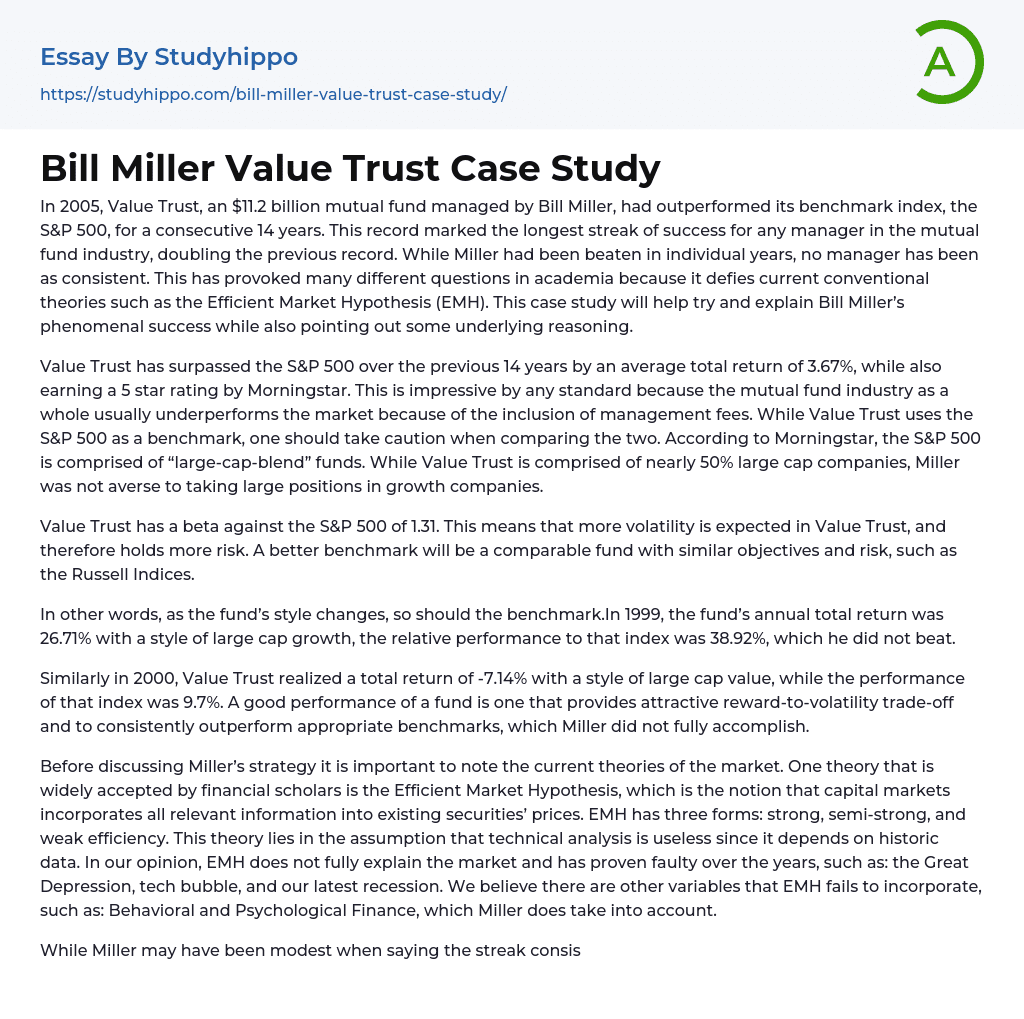In 2005, Value Trust, an $11.2 billion mutual fund managed by Bill Miller, had outperformed its benchmark index, the S&P 500, for a consecutive 14 years. This record marked the longest streak of success for any manager in the mutual fund industry, doubling the previous record. While Miller had been beaten in individual years, no manager has been as consistent. This has provoked many different questions in academia because it defies current conventional theories such as the Efficient Market Hypothesis (EMH). This case study will help try and explain Bill Miller’s phenomenal success while also pointing out some underlying reasoning.
Value Trust has surpassed the S&P 500 over the previous 14 years by an average total return of 3.67%, while also earning a 5 star rating by Morningstar. This is impressive by any standard because the mut
...ual fund industry as a whole usually underperforms the market because of the inclusion of management fees. While Value Trust uses the S&P 500 as a benchmark, one should take caution when comparing the two. According to Morningstar, the S&P 500 is comprised of “large-cap-blend” funds. While Value Trust is comprised of nearly 50% large cap companies, Miller was not averse to taking large positions in growth companies.
Value Trust has a beta against the S&P 500 of 1.31. This means that more volatility is expected in Value Trust, and therefore holds more risk. A better benchmark will be a comparable fund with similar objectives and risk, such as the Russell Indices.
In other words, as the fund’s style changes, so should the benchmark.In 1999, the fund’s annual total return was 26.71% with a style of large cap growth, th
relative performance to that index was 38.92%, which he did not beat.
Similarly in 2000, Value Trust realized a total return of -7.14% with a style of large cap value, while the performance of that index was 9.7%. A good performance of a fund is one that provides attractive reward-to-volatility trade-off and to consistently outperform appropriate benchmarks, which Miller did not fully accomplish.
Before discussing Miller’s strategy it is important to note the current theories of the market. One theory that is widely accepted by financial scholars is the Efficient Market Hypothesis, which is the notion that capital markets incorporates all relevant information into existing securities’ prices. EMH has three forms: strong, semi-strong, and weak efficiency. This theory lies in the assumption that technical analysis is useless since it depends on historic data. In our opinion, EMH does not fully explain the market and has proven faulty over the years, such as: the Great Depression, tech bubble, and our latest recession. We believe there are other variables that EMH fails to incorporate, such as: Behavioral and Psychological Finance, which Miller does take into account.
While Miller may have been modest when saying the streak consisted of 95% luck, as Stephen Jay Gould stated, “long streaks are extraordinary luck imposed on great skill.” Miller has a certain methodology when selecting companies, which could help explain his consistency. Miller believed in buying low-price, high intrinsic-value stocks, while taking a long-term view on the market. Miller’s approach was research-intensive and highly concentrated with nearly 50% of Value Trust’s assets invested in just 10 large cap companies.
One problem that our group is concerned with, that Morningstar points out, is the size
of the fund and the amount of assets it contains. The typical actively managed domestic stock mutual fund with atleast $35 billion in assets holds 265 stock and stashed 22% of assets in its top 10 holdings, while Value Trust holds only 36 stocks and squeezed 50% of assets into its top 10 holdings. This translates into a higher standard deviation and will hold more business risk. As Value Trust grows, Miller will not be able to maintain this same strategy, because he owns too much of them already.
The fund’s expense ratio of 1.7% coupled with sales fees of .7% add to the possible difficulties of the fund. Because of these factors, it would not be wise to invest in Value Trust in 2005. Even though his performance was very impressive, the odds of Miller continuing such a streak are not likely.
- Investing essays
- Asset essays
- Depreciation essays
- Discounted Cash Flow essays
- Foreign Direct Investment essays
- Funds essays
- Internal Rate Of Return essays
- Revenue essays
- Day Trading essays
- Futures Trading essays
- Capital market essays
- Million essays
- Payment essays
- Rate Of Return essays
- Funding essays
- Hedge Fund essays
- Bank essays
- Banking essays
- Corporate Finance essays
- Credit Card essays
- Currency essays
- Debt essays
- Donation essays
- Enron Scandal essays
- Equity essays
- Financial Accounting essays
- Financial Crisis essays
- Financial News essays
- Financial Ratios essays
- Financial Services essays
- Forecasting essays
- Foreign Exchange Market essays
- Free Market essays
- Gold essays
- Investment essays
- Legacy essays
- Loan essays
- Market Segmentation essays
- Money essays
- Personal finance essays
- Purchasing essays
- Retirement essays
- Shareholder essays
- Stock Market essays
- Supply And Demand essays
- Venture Capital essays
- Attitude essays
- Goals essays
- Personal Goals essays
- Personal Life essays




